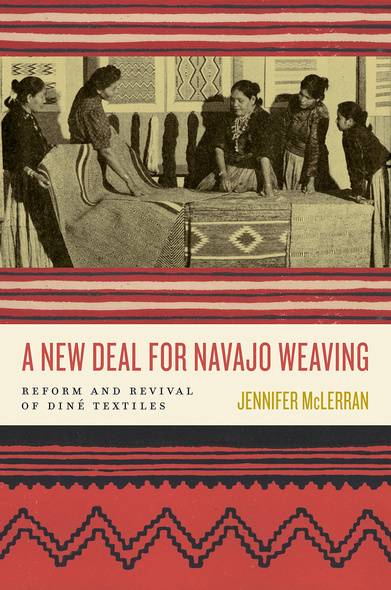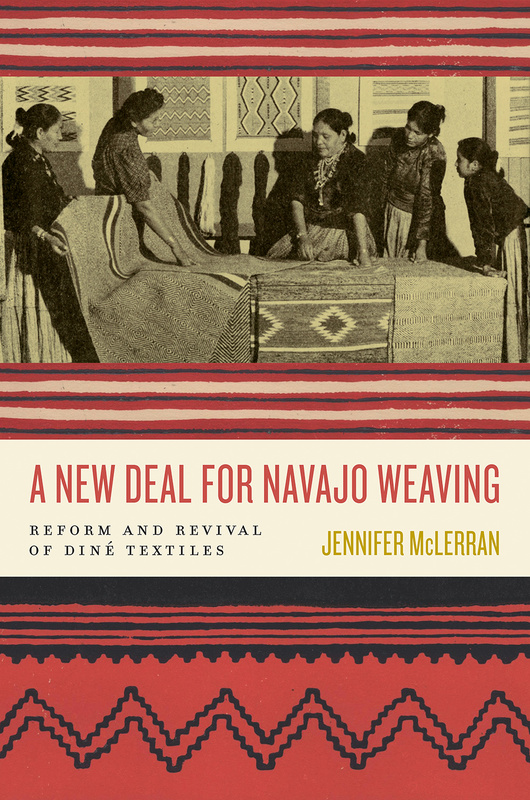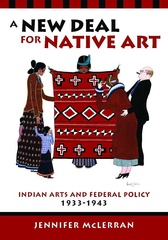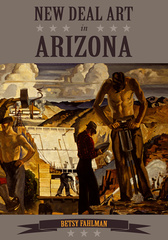
288 pages, 6 x 9
27 b&w illustrations, 8 color illustrations
Paperback
Release Date:28 May 2024
ISBN:9780816553747
A New Deal for Navajo Weaving
Reform and Revival of Diné Textiles
The University of Arizona Press
A New Deal for Navajo Weaving provides a detailed history of early to mid-twentieth-century Diné weaving projects by non-Natives who sought to improve the quality and marketability of Navajo weaving but in so doing failed to understand the cultural significance of weaving and its role in the lives of Diné women.
By the 1920s the durability and market value of Diné weavings had declined dramatically. Indian welfare advocates established projects aimed at improving the materials and techniques. Private efforts served as models for federal programs instituted by New Deal administrators. Historian Jennifer McLerran details how federal officials developed programs such as the Southwest Range and Sheep Breeding Laboratory at Fort Wingate in New Mexico and the Navajo Arts and Crafts Guild. Other federal efforts included the publication of Native natural dye recipes; the publication of portfolios of weaving designs to guide artisans; and the education of consumers through the exhibition of weavings, aiding them in their purchases and cultivating an upscale market. McLerran details how government officials sought to use these programs to bring the Diné into the national economy; instead, these federal tactics were ineffective because they marginalized Navajo women and ignored the important role weaving plays in the resilience and endurance of wider Diné culture.
By the 1920s the durability and market value of Diné weavings had declined dramatically. Indian welfare advocates established projects aimed at improving the materials and techniques. Private efforts served as models for federal programs instituted by New Deal administrators. Historian Jennifer McLerran details how federal officials developed programs such as the Southwest Range and Sheep Breeding Laboratory at Fort Wingate in New Mexico and the Navajo Arts and Crafts Guild. Other federal efforts included the publication of Native natural dye recipes; the publication of portfolios of weaving designs to guide artisans; and the education of consumers through the exhibition of weavings, aiding them in their purchases and cultivating an upscale market. McLerran details how government officials sought to use these programs to bring the Diné into the national economy; instead, these federal tactics were ineffective because they marginalized Navajo women and ignored the important role weaving plays in the resilience and endurance of wider Diné culture.
The book meticulously details the ways in which various interests in Navajo weaving came together in the early twentieth century both to revitalize the art form and to create new markets for the artists. In so doing, it provides a critical lens through which to see the challenges and limitations of federal policy on artistic practice.’—Mindy J. Morgan, author of The Bearer of This Letter: Language Ideologies, Literacy Practices, and the Fort Belknap Indian Community
‘McLerran provides a detailed history of early and mid-20th-century Diné weaving projects by non-Natives who sought to improve the quality and marketability of Navajo weaving, but in so doing failed to understand the cultural significance of weaving and its role in the lives of the Diné women. She covers reformers and revivalists; Indian traders' and government agents' early-20th-century weaving improvement projects; federal programs to improve Navajo weaving; and the Southwestern Range and Sheep Breeding Laboratory, Wingate Vocational High School, and the Navajo Arts and Crafts Guild.’ —Protoview
‘Focusing on Navajo weavers and weaving, this volume examines the effect of colonization, the loss of quality and durability, and the effect that various private and federal programs had on ‘improving’ Navajo weaving and making it an economic mainstay of Navajo families. McLerran recounts the interaction between Navajo weavers and various programs developed by outside (i.e., colonizer) groups, and how that interaction has worked at cross-purposes with both the Dine and with each other. Her acknowledgment of the damage done by these programs is especially appreciated.’— J. C. Sandstrom, CHOICE
‘McLerran reexamines familiar topics in Navajo history, such as Indian traders, the development of southwestern tourism, and the livestock reduction program, with an eye to their impact on weaving, aided by her superior practical understanding of the art. Reformers targeted every step of the weaving process, from experimenting with breeding sheep for different kinds of wool to influencing the design choices of weavers to cultivating upscale markets for fine Navajo textiles, and McLerran’s expertise allows her to examine the impacts not only through the written record, but also through the record of the textiles themselves, which are illustrated throughout the book.’ — Erica Cottam, Southwest Historical Quarterly
‘McLerran reiterates that she herself is not Diné but has collaborated with and gathered the stories of many Diné artists. Her insights help document the vital cultural information encoded in the process of weaving, the contributions of women, and emphasis on the interconnectedness of Diné lifeways and shared traditions – a sensitivity that often was a challenge when art was valued primarily for its market value rather than a reflection of a vibrant Native culture.’—KIVA Journal of Southwestern Anthropology and History
Jennifer McLerran is the author of A New Deal for Native Art: Indian Arts and Federal Policy, 1933–1943. She recently retired from Northern Arizona University, where she taught art history and museum studies.









